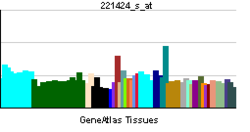- OR51E2
-
Olfactory receptor, family 51, subfamily E, member 2 Identifiers Symbols OR51E2; OR51E3P; OR52A2; PSGR External IDs OMIM: 611268 MGI: 2157548 HomoloGene: 23713 GeneCards: OR51E2 Gene Gene Ontology Molecular function • receptor activity
• olfactory receptor activityCellular component • plasma membrane
• integral to membraneBiological process • sensory perception of smell
• response to stimulusSources: Amigo / QuickGO RNA expression pattern 
More reference expression data Orthologs Species Human Mouse Entrez 81285 170639 Ensembl ENSG00000167332 ENSMUSG00000043366 UniProt Q9H255 n/a RefSeq (mRNA) NM_030774 NM_130866 RefSeq (protein) NP_110401 NP_570936 Location (UCSC) Chr 11:
4.7 – 4.72 MbChr 7:
109.89 – 109.91 MbPubMed search [1] [2] Olfactory receptor 51E2 is a protein that in humans is encoded by the OR51E2 gene.[1][2]
Olfactory receptors interact with odorant molecules in the nose, to initiate a neuronal response that triggers the perception of a smell. The olfactory receptor proteins are members of a large family of G-protein-coupled receptors (GPCR) arising from single coding-exon genes. Olfactory receptors share a 7-transmembrane domain structure with many neurotransmitter and hormone receptors and are responsible for the recognition and G protein-mediated transduction of odorant signals. The olfactory receptor gene family is the largest in the genome. The nomenclature assigned to the olfactory receptor genes and proteins for this organism is independent of other organisms.[2]
Contents
See also
References
- ^ Xu LL, Stackhouse BG, Florence K, Zhang W, Shanmugam N, Sesterhenn IA, Zou Z, Srikantan V, Augustus M, Roschke V, Carter K, McLeod DG, Moul JW, Soppett D, Srivastava S (Dec 2000). "PSGR, a novel prostate-specific gene with homology to a G protein-coupled receptor, is overexpressed in prostate cancer". Cancer Res 60 (23): 6568–72. PMID 11118034.
- ^ a b "Entrez Gene: OR51E2 olfactory receptor, family 51, subfamily E, member 2". http://www.ncbi.nlm.nih.gov/sites/entrez?Db=gene&Cmd=ShowDetailView&TermToSearch=81285.
Further reading
- Adams MD, Kerlavage AR, Fleischmann RD, et al. (1995). "Initial assessment of human gene diversity and expression patterns based upon 83 million nucleotides of cDNA sequence" (PDF). Nature 377 (6547 Suppl): 3–174. PMID 7566098. http://www.columbia.edu/itc/biology/pollack/w4065/client_edit/readings/nature377_3.pdf.
- Xia C, Ma W, Wang F, et al. (2001). "Identification of a prostate-specific G-protein coupled receptor in prostate cancer". Oncogene 20 (41): 5903–7. doi:10.1038/sj.onc.1204803. PMID 11593396.
- Yuan TT, Toy P, McClary JA, et al. (2002). "Cloning and genetic characterization of an evolutionarily conserved human olfactory receptor that is differentially expressed across species". Gene 278 (1–2): 41–51. doi:10.1016/S0378-1119(01)00709-0. PMID 11707321.
- Strausberg RL, Feingold EA, Grouse LH, et al. (2003). "Generation and initial analysis of more than 15,000 full-length human and mouse cDNA sequences". Proc. Natl. Acad. Sci. U.S.A. 99 (26): 16899–903. doi:10.1073/pnas.242603899. PMC 139241. PMID 12477932. http://www.pubmedcentral.nih.gov/articlerender.fcgi?tool=pmcentrez&artid=139241.
- Malnic B, Godfrey PA, Buck LB (2004). "The human olfactory receptor gene family". Proc. Natl. Acad. Sci. U.S.A. 101 (8): 2584–9. doi:10.1073/pnas.0307882100. PMC 356993. PMID 14983052. http://www.pubmedcentral.nih.gov/articlerender.fcgi?tool=pmcentrez&artid=356993.
- Gerhard DS, Wagner L, Feingold EA, et al. (2004). "The Status, Quality, and Expansion of the NIH Full-Length cDNA Project: The Mammalian Gene Collection (MGC)". Genome Res. 14 (10B): 2121–7. doi:10.1101/gr.2596504. PMC 528928. PMID 15489334. http://www.pubmedcentral.nih.gov/articlerender.fcgi?tool=pmcentrez&artid=528928.
- Weng J, Wang J, Cai Y, et al. (2005). "Increased expression of prostate-specific G-protein-coupled receptor in human prostate intraepithelial neoplasia and prostate cancers". Int. J. Cancer 113 (5): 811–8. doi:10.1002/ijc.20635. PMID 15499628.
- Weng J, Ma W, Mitchell D, et al. (2006). "Regulation of human prostate-specific G-protein coupled receptor, PSGR, by two distinct promoters and growth factors". J. Cell. Biochem. 96 (5): 1034–48. doi:10.1002/jcb.20600. PMID 16149059.
- Xu LL, Sun C, Petrovics G, et al. (2006). "Quantitative expression profile of PSGR in prostate cancer". Prostate Cancer Prostatic Dis. 9 (1): 56–61. doi:10.1038/sj.pcan.4500836. PMID 16231015.
- Wang J, Weng J, Cai Y, et al. (2006). "The prostate-specific G-protein coupled receptors PSGR and PSGR2 are prostate cancer biomarkers that are complementary to alpha-methylacyl-CoA racemase". Prostate 66 (8): 847–57. doi:10.1002/pros.20389. PMID 16491480.
External links
This article incorporates text from the United States National Library of Medicine, which is in the public domain.
Class II
(tetrapod specific receptors)Family 1Family 2A1 · A2 · A4 · A5 · A7 · A12 · A14 · A25 · A42 · AE1 · AG1 · AG2 · AJ1 · AK2 · AP1 · AT4 · B2 · B3 · B6 · B8 · B11 · C1 · C3 · D2 · D3 · F1 · F2 · G2 · G3 · G6 · H1 · H2 · J1 · J2 · J3 · K2 · L2 · L3 · L5 · L8 · L13 · M2 · M3 · M4 · M5 · M7 · S2 · T1 · T2 · T3 · T4 · T5 · T6 · T8 · T10 · T11 · T12 · T27 · T29 · T33 · T34 · T35 · V1 · V2 · W1 · W3 · W5 · Y1 · Z1
Family 3Family 4Family 5Family 6Family 7Family 8Family 9Family 10Family 11Family 12Family 13Categories:- Human proteins
- Transmembrane receptor stubs
- G protein coupled receptors
Wikimedia Foundation. 2010.
